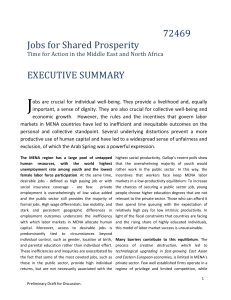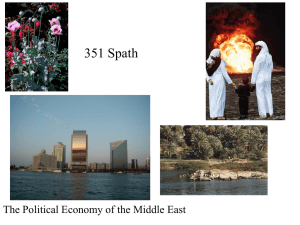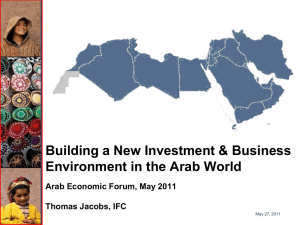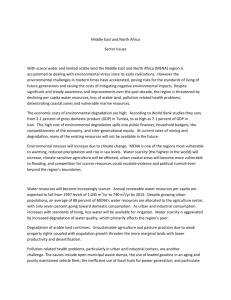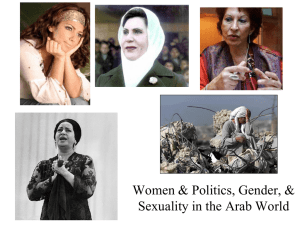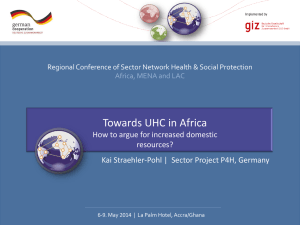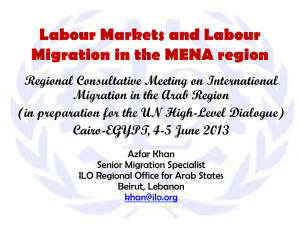Conny Beyer-The Middle Eastern Eagle. How the MENA Region can
advertisement
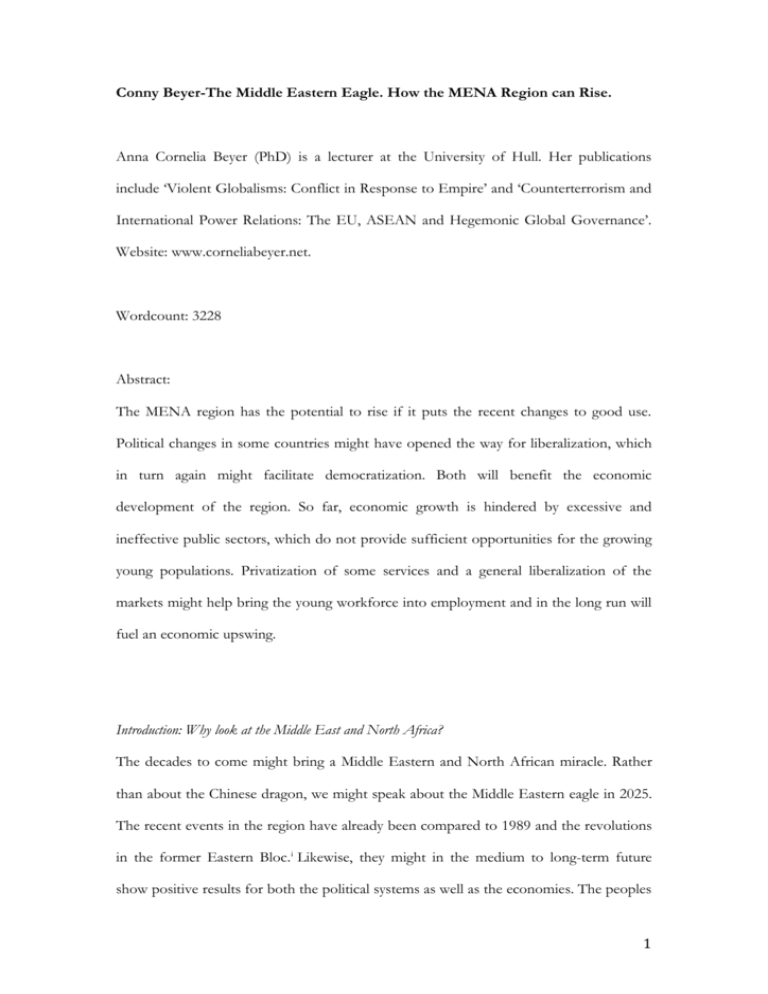
Conny Beyer-The Middle Eastern Eagle. How the MENA Region can Rise. Anna Cornelia Beyer (PhD) is a lecturer at the University of Hull. Her publications include ‘Violent Globalisms: Conflict in Response to Empire’ and ‘Counterterrorism and International Power Relations: The EU, ASEAN and Hegemonic Global Governance’. Website: www.corneliabeyer.net. Wordcount: 3228 Abstract: The MENA region has the potential to rise if it puts the recent changes to good use. Political changes in some countries might have opened the way for liberalization, which in turn again might facilitate democratization. Both will benefit the economic development of the region. So far, economic growth is hindered by excessive and ineffective public sectors, which do not provide sufficient opportunities for the growing young populations. Privatization of some services and a general liberalization of the markets might help bring the young workforce into employment and in the long run will fuel an economic upswing. Introduction: Why look at the Middle East and North Africa? The decades to come might bring a Middle Eastern and North African miracle. Rather than about the Chinese dragon, we might speak about the Middle Eastern eagle in 2025. The recent events in the region have already been compared to 1989 and the revolutions in the former Eastern Bloc.i Likewise, they might in the medium to long-term future show positive results for both the political systems as well as the economies. The peoples 1 of the Arab Spring will demand further reforms of political nature, and so far as they will be successful, these can spill over into the economies. This then again can bring economic growth, which will be essential to maintain the political progress. The so-called Arab Spring of 2011 witnessed peoples in many Middle Eastern and North African (MENA) states going to the streets to demand political reforms and to overcome the rule of autocratic leaders. While some of these struggles were successful, in Libya, Egypt and Yemen, others are still ongoing, and in Syria developed into a civil war. The motivations for these upheavals were to be found in the failing economies, which brought about food shortages and mass unemployment. These failings were rightly attributed to the leadership in these countries. Overcoming autocratic rule and the installation of more liberal systems is a first step to economic development. This paper will look in particular at the Middle East and North Africa and the dynamic and productive potential in this region. While the world is watching the unfolding of the events in the MENA region with great interest, it is unclear as of yet in which direction they will develop. Most scientists shun predictions, and so too in the case of the Arab Spring. This article will look in particular at the political and economic situations and developments and ask the question “What can be next?”. Here I will attempt to hypothesize that, if change is embraced and a strategy of privatization is implemented, there is potential for economic growth in the region. To understand the logic behind this argument, we need to look at the overall economic situation of the region in combination with the pressures coming from growing, unsatisfied populations. This serves as the background to understand the occurrence for political change in terms of liberalization and democratization. Liberalization and democratization, it is argued, can lead to a growth in the private sector of the economy, bring increased employment opportunities, and overall growth. 2 The argument: From backwardness to growth According to Barnett, the situation of the Middle East as well as Africa is representing the worldwide most extreme case of backwardness. He argued that the region is so excluded from the processes of globalization, which are thought to bring prosperity and democracy, that it represents some sort of ‘Gap’ in which life is ‘poor, nasty, short, brutal and solitary’. The ‘Gap’ to Barnett even explains the origins of the 9/11 terrorist attacks.ii Barnett finds some support in Pamuk, who argues that the growth rate of per capita income in the Middle East is strongly negative since the 1970s by comparison with the Western world. Whereas the general national income in the 19th century made up for 49 percent of the general national income of the West, it is nowadays at 20 percent. iii Halliday further supports this: ‘On index after index, the region was not just falling further behind not only Europe but also significant parts of the developing world’.iv This ‘falling behind’ has been explained with the political structures and the lack of openness and democracy. While on the one hand, Islamic law has been found to hinder economic growth, v on the other hand a correlation has been detected between the degree of democracy and economic growth. As Henry et al. put it: ‘there may be something about democracies, at least in the MENA, that predisposes them to outperform their authoritarian neighbors’.vi Fukuyama had discussed the spread of democracy at the example of the transformations in Eastern Europe. He pointed out a mechanism that was particularly relevant then and that is relevant today: The peoples in the backward regions would be exposed to images from the more developed states, and they would form a desire to emulate their success and to partake in their neighbors freedoms. vii Modernization, even if in neighboring countries, brings with it a desire for reforms. And it brings with it demands from the peoples towards their governments for increased change. viii Norton had hinted at the presence of this desire in the peoples of the Middle East already in 1993: ‘Although there 3 is wide disagreement about the outcome, among those who follow events in the Middle East, there is little doubt that regimes in the region are under increasing pressure from their citizens. … In short, the regions governments, especially the Arab ones, face a persistent crisis of legitimacy’.ix Where is this potential for dynamism coming from? At its root is a rebellion against the leaders, and to be left behind in the competitive game of globalization. It is in the desire to reach out for the benefits and goods of the latter and to partake in the freedoms and joys that Western, and other growing, societies enjoy. In particular, it is young, educated people who demand employment opportunities and an improvement in their economic situation. The Middle East provides over large masses of young people, who are keen to enter the workforce if it is made possible to them. Like China, the Middle Eastern states can profit from this young workforce, if they provide the opportunities for productive work. China relied in its growth miracle on just this: its vast, young, motivated and well-educated workforce.x The democratic growth in the region, which is higher than East Asia and Sub-Saharan Africa, for example, can be understood not only as a burden, but a blessing: ‘The changing age structure of MENA’s population has placed the region in a unique position … Between 1990 and 2020, the growth of the economically active population (ages 15-64) will exceed that of the economically dependent population by a much greater magnitude than in any other region.xi Furthermore, the working force is growing by young people and women increasingly entering, and these are increasingly better more educated.xii However, unemployment among young, educated people is still high. This is due to a lack of growth in productivity, which then again is related to the weakness of the private sector compared to the public sector, which is caused by systems of governance, size and scope of government intervention in the market, and reluctance to integrate with the world economy.xiii 4 The evidence: Potentials for development Gunilla Carllson, Swedish Minister for Development Cooperation, remarked at a public lecture given at the London School of Economics: ‘We know that safeguarding the rule of law and equality before the law, upholding the ground rules of a market economy, including the protection of property rights and contractual freedom, protecting free media and freedom of expression, all create conditions conducive to economic growth’.xiv Democracy and human rights are critical to overcome poverty and to create economic growth. For both, the region has positive potential. Democracy has come in some countries experiencing upheavals, and it might spread throughout the Middle East and North Africa, a situation long desired by the West, the United States in particular. With democratization can come an opening up of the economies and liberalization. And liberalization will act as a motor for the economy, which will restructure and grow. Human capital is in supply in excess, and it is increasingly well trained, as many MENA countries have implemented successfully some education reform programs. However, there are still challenges to overcome, such as to increase the enrollment in secondary and tertiary education, and to shift enrollment in university from humanities and social sciences towards science and engineering. xv In addition, much of the education that is given is wasted due to unemployment. The Middle East and North Africa have an unemployment rate 14 percent higher than anywhere else in the world, except Sub-Saharan Africa. Nearly every country in the region is affected, and in some countries the unemployment rate is 20 percent or higher.xvi The key for economic success is therefore in a reform of the economy that must result in an expansion of the labor market to soak up the qualified and educated workforce. Lack of adequate opportunities for educated workers creates a vicious circle: ‘Even when the region was able to employ its educated labor force, these individuals were not fully deployed to their most productive uses. Thus, at least a fraction of the 5 employed finds itself caught up in a low productivity-low return to investment in education trap. Low productivity leads to low returns to education, and low returns to education lead to low investment in education, thus lowering productivity, and so on’.xvii The stagnation in the labor market is mainly a ‘legacy of public sector employment and employment intervention stemming from the region’s state-led and redistributive models of economic and social development’. xviii Since the 1950s and 1960s, MENA governments ‘nationalised major assets and took direct control of economic production, public sector employment emerged increasingly as a primary engine for job creation during the 1970s and 1980s’ xix . The public sector probably poses a hindrance to economic growth and is now in part responsible for the unemployment problem. On the other hand, the private sector is blatantly underdeveloped, contributing on average less than 50 percent of the GDP. The World Bank explains: ‘Many policies, taken together, have limited the ability for a stronger private sector to emerge in MENA and be a source for investment and job growth. A host of cumbersome and costly business and regulatory procedures, underdeveloped financial sectors, and insufficient trade exposure have all hindered the creation and functioning of a dynamic and competitive private sector’.xx The MENA region can grow if it follows specific reforms. The public sector is highly inefficient: the reliance on widespread employment in the public sector needs to be countered by strengthening the private sector. In the MENA region, agriculture declines, and manufacturing is stalled. The most dynamic sector is services. There is an increase in informal employment. A rationalization of the public sector, with its high use of finance and overstaffing, would result in growth in private sector employment long-term, probably first in the service sector, and could bring positive results: ‘In the short run, the empirical simulations suggest that the unemployment rate of unskilled workers will increase even though, as unskilled wages fall, the private sector increases its hiring of 6 workers and informal sector employment expands. In the long run (over 10 years), however, reducing public sector employment increases private sector investment and unskilled [and skilled] employment in the formal private sector. xxi Furthermore, a reduction in wages in the public sector will lead to higher employment of skilled workers in the formal private sector. Both skilled and unskilled workers will benefit from lower unemployment rates. The Worldbank argues that wages for skilled workers in the private sector will decline; unskilled workers will face an increase in wages. xxii Dependent on technological development and participation in globalization there might be a long-term polarization in wages between skill levels.xxiii Overall, a number of studies suggest that privatization contributes to reduced unemployment and increased growth.xxiv In order to reap the benefits of the beneficial aspects of its situation, the region needs to engage in legal and regulatory reforms.xxv Soft budget restraints limited the willingness to reform in the MENA in the 1980s and 1990s. The governments, reliant on foreign aid and oil revenues, pursued reforms only reluctantly and decoupled economic and political reforms, which are inter-linked. xxvi So far, resistance to reform has benefited older workers, and has hindered privatization of public enterprises; also current Western practices, such as temporary contracts, are not integrated into the legal code. All of this hinders flexibility in the job market, prevents growth in employment and economic growth. xxvii With the current changes in the region, there is the opportunity for more reforms. The main goal would be a strengthening of the private sector versus the public sector, which should bring with it an increased integration with the world markets, and a diversification of the economic activities away from the oil trade. This strategy has been partly pursued by Iraq after the overthrow of Saddam Hussein, and in 2011 growth was rated at 9.9 percent.xxviii While Iraq’s success is heavily dependent on oil trade and the lifting of the sanctions that had crippled the country before 2003, a growing private 7 sector, real estate, construction, retail, and wholesale trade also fuel it. Privatization also has been a central tenet for growth in the recent decades in Eastern Europe and China.xxix Furthermore, for these reforms to be successful, support from external partners would be helpful. Europe is MENA’s most important trade partner, together with other countries and regions; it needs to help integrate MENA in the world economy. Interregional trade needs to intensify and sanctions being lifted. In addition, the region would welcome financial support via foreign aid.xxx So far, the positive side and prognoses for the future of the MENA region have been discussed. But there is also a downside. A backlash towards authoritarianism and tyranny is threatening. The rise of the Muslim Brotherhood to power in Egypt, for example, could indicate a backlash similar to the developments that Iran has experienced after its 1979 revolution. This would have a negative impact on the prospects for democratic development, and it will in turn depend on the potential for economic growth. Democracies survive best when the economic conditions are favorable. ‘[O]nce democracy is established, for whatever reasons, its survival depends on a few, easily identifiable, factors. Foremost among them is the level of economic development, as captured by per capita income’.xxxi If the opportunities now are not taken, the region will not be able to reap the benefits. Therefore, the economic reforms discussed above are essential, not only for economic growth, but also for the sustainability of democracy. Conclusion: A better future is possible It is clear that MENA is a region of great dynamism. The changes that we observed in the past year and that still are going on mean that we will see even more developments in the decades to come. If the danger of a backlash towards authoritarianism and tyranny can be averted, the region has the potential of growth. It is the political opening up in the region that will lead to some economic changes and spur growth and progress. In its very 8 essence, it is the dynamic and productive potential that rests within the societies and their peoples. The recent developments in the region indicate this immense politically creative potential. It might spur further revolutions and reforms, which in the long run are hoped to spill over and pay off in the economy. Similar to the political changes in the former Eastern Bloc countries, political changes in MENA can in the medium term bring economic reforms. This might lead short-term to difficulty and crisis, as Russia experienced after its embrace of capitalism, and as is experienced in many Arab Spring states currently.xxxii But in the long-term, it will pay off with growth. If, at least in some states the tyranny of autocrats is removed, and politically more responsive systems will be put in place, this should also lead to more entrepreneurial freedom. Opening up these societies will enable new forms of businesses to take root and new jobs opening up. This then again will feed back into the societies, make them more open to modernization, and empower the people to claim further rights and participation in the political process. i Charles Sullivan, “Riding the Revolutionary Wave: America, The Arab Spring and the Autumn of 1989”, The Washington Review of Turkish and Eurasian Affairs, April 2011, accessed August 9, 2012, http://www.thewashingtonreview.org/articles/riding-therevolutionary-wave-america-the-arab-spring-and-the-autumn-of-1989.html. ii Thomas P. M. Barnett, The Pentagon’s New Map. War and Peace in the twenty-first Century (New York: Berkley Books, 2004). iii Sevket Pamuk, “Estimating Economic Growth in the Middle East since 1820”, The Journal of Economic History, 66, (2006), 809-828. iv Fred Halliday, The Middle East in International Relations: Power, Politics and Ideology (Cambridge: Cambridge University Press, 2005), 265. v Timur Kuran, “Why the Middle East is Economically Underdeveloped: Historical Mechanisms of Institutional Stagnation” Journal of Economic Perspectives, 18 (2004), 71-90. viM. Clement Henry and others, Globalization and the Politics of Development in the Middle East (Cambridge: Cambridge University Press, 2010), 271. vii Francis Fukuyama, The End of History and the Last Man (London: Penguin Books, 1992). viii Ivo Feierabend and Rosalind Feierabend, “The cross-national analysis of political instability”, in James Chowning Daview (ed.) When men revolt and why. A reader in political violence and revolution (London: The Free Press, 1971), 229-249, 240-243. ix Augustus Richard Norton, “The Future of Civil Society in the Middle East”, Middle East Journal, 47, no. 2 (1993), 205-216, 205. 9 x Judith Banister et al, “Population Aging and Economic Growth in China”, Program on the Global Demography of Aging Working Paper No. 53, accessed August 8, 2012, http://www.hsph.harvard.edu/pgda/WorkingPapers/2010/PGDA_WP_53.pdf. xi The World Bank, Unlocking the Employment Potential in the Middle East and North Africa. Toward a New Social Contract MENA Development Report. Washington D.C. 2004, 54. xii The World Bank, Unlocking, 66. xiii The World Bank, Unlocking, 82. xiv Gunilla Carlsson, “Why human rights and democracy are critical to overcome poverty” Lecture at the London School of Economics, 2011, accessed July 31, 2012, http://www2.lse.ac.uk/assets/richmedia/channels/publicLecturesAndEvents/transcript s/20110307_1800_whyHumanRightsAndDemocracy_tr.pdf, 7. xv The World Bank, The Road Not Travelled. Education Reform in the Middle East and North Africa. MENA Development Report. Washington D.C. 2008. 20. xvi The World Bank, The Road, 212. xvii The World Bank, The Road, 215. xviii The World Bank, The Road, 225. xix The World Bank, The Road, 229. xx The World Bank, The Road, 229. xxi The World Bank, Unlocking, 134. xxii The World Bank, Unlocking, 134. xxiii Maarten Goos et al., ‘The Polarization of the European Labor Market’, American Economic Review Papers and Proceedings, 90:2, 2009, 271-275. xxiv Steven Barnett, ‘Evidence on the Fiscal and Macroeconomic Impact of Privatization’, IMF Working Paper WP/00/130; Anastassios Gentzoglanis, ‘Privatization and Economic Growth: Evidence from MENA Countries’, accessed August 15, 2012, http://userpage.fu-berlin.de/~jmueller/its/conf/helsinki03/papers/Gentzoglanis.pdf; William L. Megginson and Jeffrey M. Netter, From State to Market: A Survey of Empirical Studies on Privatization’, Journal of Economic Literature, 39:2, 2001, 321-389. xxv Adnan Filipovic, ‘The Impact of Privatization on Economic Growth’, Issues in Political Economy, 14, 2005, accessed August 15, 2012, http://org.elon.edu/ipe/Adi%20final.pdf; Paul Cook and Yuichiro Uchida, ‘Privatisation and economic growth in developing countries’, Journal of Development Studies, 39:6, 121-154. xxvi The World Bank, Unlocking, 14. xxvii The World Bank, Unlocking, 150. xxviii CIA, “Iraq”, The World Factbook, accessed August 7, 2012, https://www.cia.gov/library/publications/the-world-factbook/geos/iz.html. xxix Yingyi Qian and Jinglian Wu, “China’s Transition to a Market Economy. How Far Across the River?’’ in Nicolas Hope and others (eds.) How Far Across the River? (Stanford: Stanford University Press, 31-63. xxx The World Bank, Unlocking, 16. xxxi Adam Ptrzeworski, “Democracy and Economic Development”, in: Mansfield, Edward D. and Richard Sisson (eds.) The Evolution of Political Knowledge (Columbus: Ohio State University, 2004) 300-324, 312 xxxii Raed Charafeddine, “The Economic and Financial Impacts of the Arab Awakening”, accessed August 8, 2012, http://belfercenter.ksg.harvard.edu/files/The%20Economic%20and%20Financial%20I mpacts%20of%20the%20Arab%20Awakening%20%20Raed%20H%20%20Charafeddine%20-%20Sep%20%202011.pdf, 8f. 10
